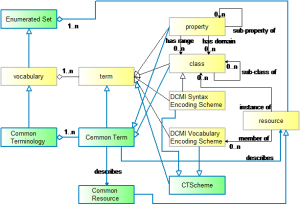Definition, Roles and Benefits of CT
Definition of CT
Common Terminology (CT) is defined as a set of Common Terms. The Common Terms can be common terms of elements names of different metadata schemas, or common terms of thesaurus and controlled vocabularies for subject cataloging. However, the suggested Common Terminology (CT) in the project is not subject vocabulary or thesaurus terms. The CT is confined to common terms, especially, common element names of widely used metadata schemas (e.g., MARC, MODS, DC & QDC). The definitions of terms used in the CT abstract model are:
- A Common Terminology is a set of Common Terms (including qualifiers).
- A Common Term is property (element), or class.
- A property (sub-property) can be one kind of common element (field) or attribute (subfield) in two or more metadata schemas.
- A class is “a group containing members that have attributes, [behaviors], relationships or semantics in common or a kind of category” (DCMI, 2013).
- A CTScheme is an enumerated set of resources used as a controlled set of values including authorities, Syntax Encoding Scheme of DCMI and Vocabulary Encoding Scheme. CTScheme includes: CTTypeGenre, CTFormat, CTRelator, CTLanguage, CTDescription, CTIdentifier, and CTSubject.
The CT Abstract Model based on DCMI abstract model (DCMI, 2013).
Roles and Benefits of CT
- First, the most important role is to embrace various metadata schemas and to provide uniformity. It allows communities to still use their best ways to describe and preserve metadata according to their needs.
- It achieves interoperability at multiple levels (schema, schema definition language, record, and repository levels). It, thus, gives a common standard way in achieving interoperability at metadata multiple levels.
- It plays a role to maintain balance between different degrees of generality or specificity of existing metadata schemas. It minimizes loss of information in transferring or mapping data between them.
- Finally, it provides a certain way that communities can share their data or databases, and work together (Jin, 2014).

